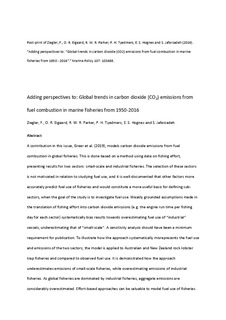| dc.description.abstract | A contribution in this issue, Greer et al. (2019), models carbon dioxide emissions from fuel combustion in global fisheries. This is done based on a method using data on fishing effort, presenting results for two sectors: small-scale and industrial fisheries. The selection of these sectors is not motivated in relation to studying fuel use, and it is well-documented that other factors more accurately predict fuel use of fisheries and would constitute a more useful basis for defining sub-sectors, when the goal of the study is to investigate fuel use. Weakly grounded assumptions made in the translation of fishing effort into carbon dioxide emissions (e.g. the engine run time per fishing day for each sector) systematically bias results towards overestimating fuel use of “industrial” vessels, underestimating that of “small-scale”. A sensitivity analysis should have been a minimum requirement for publication. To illustrate how the approach used by Greer et al. (2019) systematically misrepresents the fuel use and emissions of the two sectors, the model is applied to Australian and New Zealand rock lobster trap fisheries and compared to observed fuel use. It is demonstrated how the approach underestimates emissions of small-scale fisheries, while overestimating emissions of industrial fisheries. As global fisheries are dominated by industrial fisheries, the aggregate emission estimate is likely considerably overestimated. Effort-based approaches can be valuable to model fuel use of fisheries in data-poor situations, but should be seen as complementary to estimates based on direct data, which they can also help to validate. Whenever used, they should be based on transparent, science-based data and assumptions. | nb_NO |

